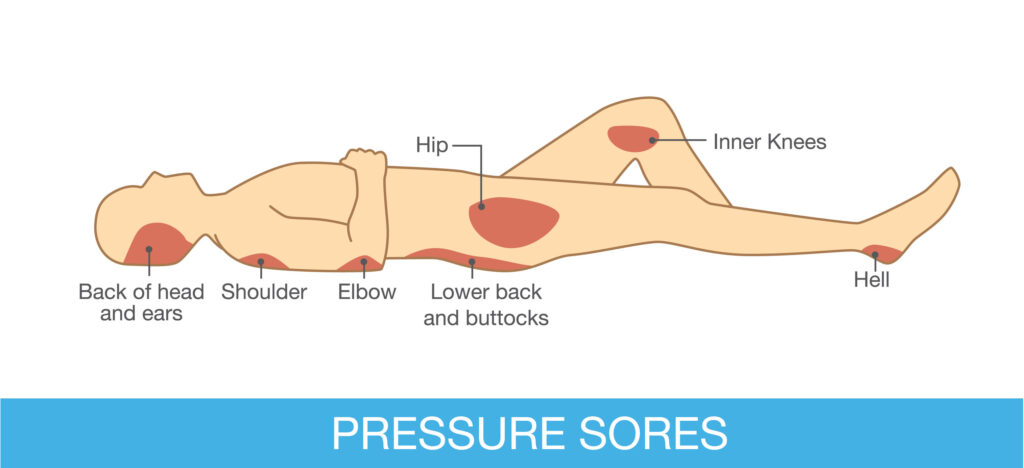Pressure Ulcer Treatment In Pakistan

If you or your loved one is suffering from a disease that severely restricts movements, then you are at risk of developing pressure ulcers. Read further to know everything about pressure ulcers and pressure ulcer treatment in Pakistan by BioFlex for rapid healing of the wound.
If not treated properly, the damage to the skin can penetrate deep, reaching muscles and bones. So it is important to notice the skin condition of the patient and undergo pressure ulcer management and prevention as soon as possible.
If you can relate to this condition and want to know more, keep reading.
What’s a Pressure Ulcer?
Pressure ulcers, also called Decubitus ulcers, bedsores, or superficial ulcers, are familiar terms for those who are bedridden or use a wheelchair frequently.
A pressure ulcer develops on the skin as a result of added pressure when movement is restricted. The bony parts of the body, like elbows, ankles, hips and knees experience immense pressure when they aren’t moved much. As a result, the skin in these areas of the body gets damaged due to the decrease in blood flow. The skin gets red and then purplish, forming a wound.
Those suffering from impairment in wheelchairs may suffer pressure ulcers on the buttocks from sitting.
Without proper management of the pressure ulcer, the wound starts penetrating deep into the muscles and bones, causing severe injuries to the skin and underlying tissue which results in infection.
That’s why it’s important to frequently monitor the skin of the patient by a caretaker or relative, contact the doctor immediately and take necessary preventive measures in case you notice the slightest symptoms of pressure ulcers.
Let’s have a look at the symptoms and causes of pressure ulcers to understand the condition in a better way and thus opt for the best possible pressure ulcer treatment option.
Symptoms of Pressure Ulcers
The signs and symptoms of pressure ulcers vary according to their severity. Usual symptoms include:
- Redness of the skin
- Change in the texture of the skin
- Skin discoloration
- Swelling
- Pus-like drainage from the skin
- Tender skin
- The skin forming ulcers becomes hotter or cooler than other body parts
- Painful and purplish skin
A few symptoms like swelling and change in the colour and texture of the skin are warning signs that shouldn’t be neglected, whatsoever. Other symptoms like pus and purple skin signal an advanced skin ulcer that needs immediate attention.
Causes of Pressure Ulcers
As the name suggests, pressure ulcers are caused by the pressure applied against the skin as a result of immobility.
The skin that isn’t moved for hours gets less oxygen due to restricted blood flow. As a result, the skin starts dying, causing wounds.
Here are the causes of pressure ulcers, one by one:
Friction
The friction is caused when the skin is rubbed against the bed sheet vigorously. The sensitive skin becomes red and if not treated, can turn into a wound. The friction can also occur when the patient moves in a wheelchair.
Pressure
The pressure is applied against the skin that isn’t moved much and doesn’t have a fatty layer on it. So, the bony parts of the body are prone to bedsores. The pressure restricts blood flow and hence the skin becomes deprived of oxygen and other nutrients. This causes wounds and ulcers.
Shear
Shear happens when the skin is moved opposite to an object, causing it to be rubbed and damaged. For example, pressure ulcers can develop if the patient slides down when the head of the bed is moved up.
All the possible causes of a pressure ulcer should be known to prevent it from worsening.
Pressure Ulcer Stages And Possible Treatment
A pressure ulcer is classified into various stages, based on tissue damage. The doctor investigates the wound and classifies it into any of the 4 stages for proper treatment and speedy recovery.
Let’s look into 4 pressure ulcer stages:
Stage 1
This is the initial phase of ulcer formation. The skin starts to change its colour to reddish-purple. The affected area might be painful and a bit swollen. The temperature of that area will be cooler or hotter than the entire body.
The doctor will press the reddish area to see if it turns yellow. If it doesn’t turn yellow then it means the blood supply is interrupted. Further negligence can allow the ulcer to move inside the skin and convert to a stage II ulcer.
Stage 1 Pressure Ulcer Treatment
Stage I ulcers can get better in a couple of days if treated properly. The first thing to do is change position as much as you can. Changing position removes pressure from that area and improves blood flow.
Stage 2
If stage I ulcer remains unattended, the wound penetrates the deeper layers, causing a shallow wound. The wound may or may not be filled with pus.
The chances of getting an infection through this wound are higher if it’s open and isn’t taken care of.
The area around the wound swells and the wound may also seem like a blister filled with pus.
Stage 2 Pressure Ulcer Treatment
The treatment includes all the necessary steps that remove pressure from the ulcer.
Changing position frequently and keeping the wound dry and clean is the key to recovery. You should also consult a doctor for proper treatment as a stage II ulcer can affect bones and muscles as well.
It takes more than 3 weeks for a stage II ulcer to heal, provided proper medical attention is given.
Stage 3
If the pressure ulcer isn’t treated early then the wound breaks into the deep layers of the skin. This causes severe pain and infection.
The wound looks like a crater, smelling foul. If you think you or your loved one is having a stage III ulcer then contact your doctor ASAP.
Stage 3 Pressure Ulcer Treatment
Contact your doctor immediately to seek proper medical help. Your doctor might prescribe antibiotics to get rid of the infection. The wound will be cleaned frequently.
The doctor might also prescribe a special mattress or bed through which air passes easily. This releases the pressure that the body was feeling otherwise due to lack of movement.
It takes 1 to 4 months or more for a stage III ulcer to heal.
Stage 4
The last and most severe stage of pressure ulcer is stage IV. The wound penetrates deep into muscles, tendons, and ligaments. In worse cases, it reached bones as well.
The wound smells foul, with immense pain I’m swelling.
Stage 4 Pressure Ulcer Treatment
At this stage, it’s important to consult the doctor immediately. You might need hospitalization for proper care and treatment.
It takes a year or more for a stage IV ulcer to heal completely, and that also with extensive medical care.
Alternative Pressure Ulcer Treatment in Pakistan
If you’re suffering from pressure ulcers and want to get rid of them, safely and effectively, then you can opt for alternative treatment options. One of the alternative treatments is laser pain therapy. The procedure uses a cold laser to heal the wound and reduce pain, swelling, and infection.
Let’s dig deeper to know how laser therapy helps you keep pressure ulcers at bay.
Laser Pain Therapy
Laser pain therapy is an advanced, non-invasive treatment to help the body heal naturally.
More than 4000 studies have shown that laser pain therapy is an effective treatment to reduce pain and allow wounds to heal, without any medications and invasive procedures.
You can easily benefit from this therapy in Pakistan by expert doctors. BioFlex Pakistan offers laser pain therapy to treat pressure ulcers effectively.
Click here to know more about us and how you can approach Pakistan’s most experienced doctors, performing laser pain therapy successfully over years.
Watch this video by Dr. Faiza Asghar, a general practitioner and consultant at BioFlex Pakistan. She explains how pressure ulcers are treated using laser therapy.
Pressure Ulcer Management
Getting proper treatment of pressure ulcers is inevitable. That said, you should manage the ulcers at home alongside. Take the help of your relative or caretaker to manage pressure ulcers and heal faster. You should:
- Change position frequently to reduce pressure
- Drink plenty of water and fluids to detoxify your body and thus prevent infections
- Have a good diet. Consume lots of protein and calcium
- Keep your wound dry and properly ventilated
- Keep your wound clean with saline solution and use ointments if prescribed by your doctor
- Clean the wounds every couple of hours
- Take the help of your caretaker and call your doctor if you feel pain and swelling
Pressure Ulcer Prevention
Prevention is better than cure. That’s why the team taking care of a bedridden patient should take measures to prevent bedsores.
Repositioning
Changing sides after intervals help reduce the pressure applied by the bed and promote blood flow to the affected area. Read below to see the best positions to prevent pressure ulcers.
Special Mattresses
There are mattresses in the market designed to provide proper air to all the body parts. This reduces pressure and increases blood flow.
Proper ventilation
Make sure the body is dry and there’s no sweat. This makes the skin properly ventilated and this prevents ulcer formation.
Healthy diet
Take a lot of calcium and protein to keep your skin healthy and bones strong. A healthy diet makes your immune system strong and keeps away infections as well.
Best Positions to Prevent Pressure Ulcers
The best positions to prevent pressure ulcers caused by friction and shear are:
- Use a 30-degree side-lying position
- Alternate the side-lying position between the left and right side
- Schedule regular repositioning in this position after intervals
The Bottom Line
If you or your loved one is bedridden and suspects pressure ulcers then this article is for you. Above is a detailed understanding of bedsores, also called pressure ulcers, along with the possible treatment options.
You’ll also come to know about an advanced pressure ulcer treatment in Pakistan through laser therapy that rapidly heals wounds and is completely safe.
Click here to know more about how laser pain therapy is done at our advanced laser therapy clinic (BioFlex Pakistan) to treat all 5 stages of pressure ulcers.


